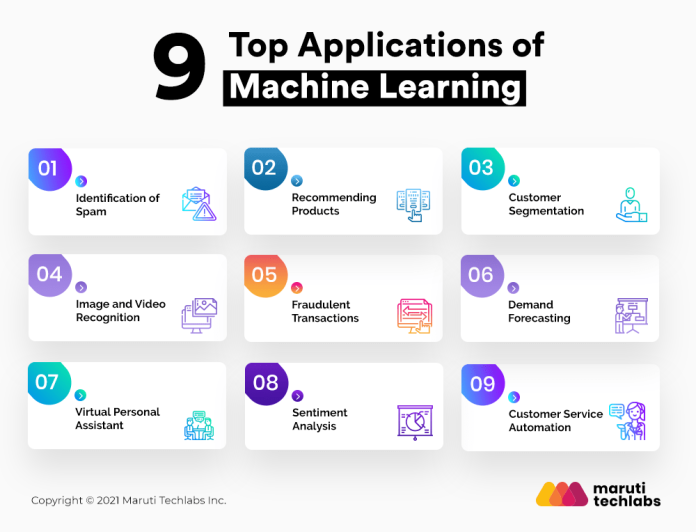Applications of Machine learning are many, including external (client-centric) applications such as product recommendation, customer service, and demand forecasts, and internally to help businesses improve products or speed up manual and time-consuming processes.
Machine learning algorithms are typically used in areas where the solution requires continuous improvement post-deployment. Adaptable machine learning solutions are incredibly dynamic and are adopted by companies across verticals.
Here we are discussing nine Machine Learning use cases –
1. Identifying Spam
Spam identification is one of the most basic applications of machine learning. Most of our email inboxes also have an unsolicited, bulk, or spam inbox, where our email provider automatically filters unwanted spam emails.
But how do they know that the email is spam?
They use a trained Machine Learning model to identify all the spam emails based on common characteristics such as the email, subject, and sender content.
If you look at your email inbox carefully, you will realize that it is not very hard to pick out spam emails because they look very different from real emails. Machine learning techniques used nowadays can automatically filter these spam emails in a very successful way.
Spam detection is one of the best and most common problems solved by Machine Learning. Neural networks employ content-based filtering to classify unwanted emails as spam. These neural networks are quite similar to the brain, with the ability to identify spam emails and messages.
2. Making Product Recommendations
Recommender systems are one of the most characteristic and ubiquitous machine learning use cases in day-to-day life. These systems are used everywhere by search engines, e-commerce websites (Amazon), entertainment platforms (Google Play, Netflix), and multiple web & mobile apps.
Prominent online retailers like Amazon and eBay often show a list of recommended products individually for each of their consumers. These recommendations are typically based on behavioral data and parameters such as previous purchases, item views, page views, clicks, form fill-ins, purchases, item details (price, category), and contextual data (location, language, device), and browsing history.
These recommender systems allow businesses to drive more traffic, increase customer engagement, reduce churn rate, deliver relevant content and boost profits. All such recommended products are based on a machine learning model’s analysis of customer’s behavioral data. It is an excellent way for online retailers to offer extra value and enjoy various upselling opportunities using machine learning.
3. Customer Segmentation
Customer segmentation, churn prediction and customer lifetime value (LTV) prediction are the main challenges faced by any marketer. Businesses have a huge amount of marketing relevant data from various sources such as email campaigns, website visitors and lead data.
Using data mining and machine learning, an accurate prediction for individual marketing offers and incentives can be achieved. Using ML, savvy marketers can eliminate guesswork involved in data-driven marketing.
For example, given the pattern of behavior by a user during a trial period and the past behaviors of all users, identifying chances of conversion to paid version can be predicted. A model of this decision problem would allow a program to trigger customer interventions to persuade the customer to convert early or better engage in the trial.
4. Image & Video Recognition
Advances in deep learning (a subset of machine learning) have stimulated rapid progress in image & video recognition techniques over the past few years. They are used for multiple areas, including object detection, face recognition, text detection, visual search, logo and landmark detection, and image composition.
Since machines are good at processing images, Machine Learning algorithms can train Deep Learning frameworks to recognize and classify images in the dataset with much more accuracy than humans.
Similar to image recognition, companies such as Shutterstock, eBay, Salesforce, Amazon, and Facebook use Machine Learning for video recognition where videos are broken down frame by frame and classified as individual digital images.
5. Fraudulent Transactions
Fraudulent banking transactions are quite a common occurrence today. However, it is not feasible (in terms of cost involved and efficiency) to investigate every transaction for fraud, translating to a poor customer service experience.
Machine Learning in finance can automatically build super-accurate predictive maintenance models to identify and prioritize all kinds of possible fraudulent activities. Businesses can then create a data-based queue and investigate the high priority incidents.
It allows you to deploy resources in an area where you will see the greatest return on your investigative investment. Further, it also helps you optimize customer satisfaction by protecting their accounts and not challenging valid transactions. Such fraud detection using machine learning can help banks and financial organizations save money on disputes/chargebacks as one can train Machine Learning models to flag transactions that appear fraudulent based on specific characteristics.
6. Demand Forecasting
The concept of demand forecasting is used in multiple industries, from retail and e-commerce to manufacturing and transportation. It feeds historical data to ML algorithms and models to predict the number of products, services, power, and more.
It allows businesses to efficiently collect and process data from the entire supply chain, reducing overheads and increasing efficiency.
ML-powered demand forecasting is very accurate, rapid, and transparent. Businesses can generate meaningful insights from a constant stream of supply/demand data and adapt to changes accordingly.
Read Full Article Here












